THE AIRPORTS
SOUTHERN CALIFORNIA
SANTA ANA-ORANGE COUNTY
SNA
| What was started as thousands of acres of both lemon and orange orchards and cattle ranches evolved into one of the busiest and populous regions in United States. During the 1920s a celery farm was purchased and a private airstrip was built by aviation pioneer Eddie Martin, just south of the county seat of Santa Ana. The airport remained a general aviation field for many years as Orange County was still rather rural and most population growth was taking place in Los Angeles just thirty miles to the north. In 1951, local service carrier, Bonanza Air Lines added Santa Ana as a destination on its multi-stop Phoenix-Los Angeles service using the Douglas DC-3. (Santa Ana was the stop between Oceanside and Los Angeles) Bonanza started "jet-prop" service using Fokker F-27s in 1963, followed by non-stop flights to Las Vegas. The airport received its first pure jet service in late 1967 with flights to Phoenix by Bonanza Airlines. Hometown carrier Air California started operations from Santa Ana-Orange County in early 1967 and firmly put the airport as a viable alternative to congested Los Angeles-LAX to the north. With the increase in passenger flights and the rapid growth of the region, including the Disneyland theme park just miles away, a new passenger terminal was constructed and placed into operation in 1967. Over the next few years, airport expansion remained "in-check" with Air California dominating the services. During the 1980s the airport saw tremendous growth in terms of passengers and new airlines starting service. Orange County had become a top spot for many nationwide businesses and technology firms and the airlines followed suit. By 1985, eight airlines were serving the airport with non-stop flights as far east as Denver, Chicago and Dallas-Ft. Worth. Although considered one of the most sensitive airports from aircraft noise profiles due to the surrounding region, Orange County grew to become a busy regional airport for both general and business aviation as well as passenger carriers. |
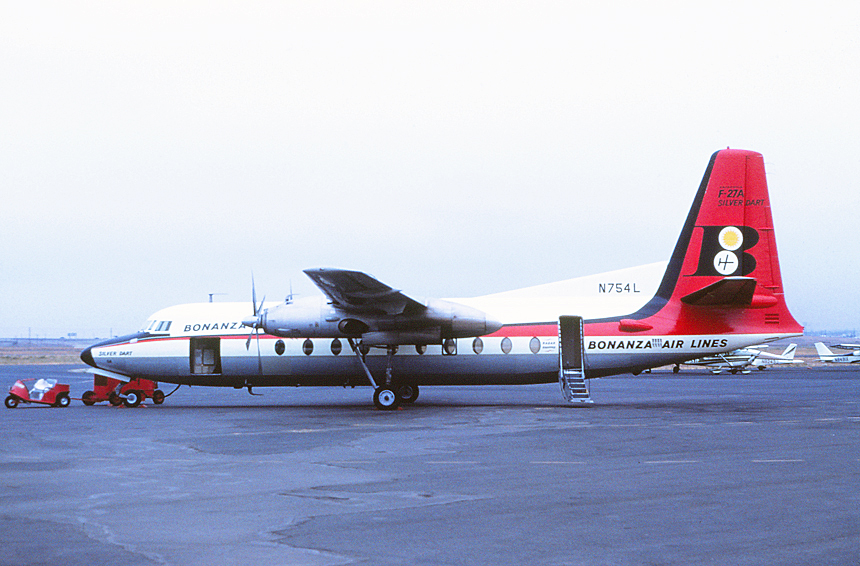
|
June 1967 Local service carrier, Bonanza Air Lines had grown from a small, single-plane operation to a profitable airline based in Las Vegas, Nevada during the 1950s. Focusing its efforts on the popular Las Vegas-Reno market, Bonanza eventually added flights From Vegas to Phoenix, Arizona and a multi-stop Phoenix-Los Angeles service with Douglas DC-3s. These pioneering routes placed Bonanza as a popular option for travel to the growing, gambling mecca of Las Vegas. Visionary President Edmund Converse, was always looking for ways to improve passenger travel and comfort over the sometimes desolate distances covered. With the DC-3s starting to show their age, Converse sought new equipment and traveled to Europe when Fokker courted the executive with their new 44-passenger, high-winged F-27 turboprop. Immediately impressed, an order was placed for six of the F-27s in 1957, at a cost of $850,000 each. Named “Silver Darts” after the Silver State, Nevada nickname and the Rolls Royce Dart turboprop engines, the first Fokker F-27 was received in January 1959, and placed on the Las Vegas-Reno route. By November 1960, eight of the F-27s had been received and the last of the DC-3s finally retired which made Bonanza the first all-jet powered airline in America, a phrase they used to their marketing advantage. With the F-27 turboprop, cities in the Bonanza route structure such as Riverside and Blythe, California and Kingman and Grand Canyon, Arizona received modern airplane service for the first time. One of these airports, Orange County-Santa Ana welcomed the F-27 service in late 1959 and Bonanza became the first airline to start “jet” service into the airport. Bonanza would eventually acquire sixteen of the F-27 airplanes before being merged into Air West Airlines in April 1968. Parked on the ramp at Orange County-Santa Ana Airport and awaiting its next load of passengers is N754L, a Fokker F-27A, delivered new to the airline on April 5, 1962. |

|
July 1967 Initially using two Lockheed L-188 Electra turboprop aircraft, Air California started operations in January 1967, with five daily flights between Orange County-Santa Ana and San Francisco. Parked on the ramp and being serviced before another flight to the Bay Area is N359AC, a Lockheed L-188 Electra-C originally delivered to QANTAS in October 1959, and purchased by Air California in June 1967. |
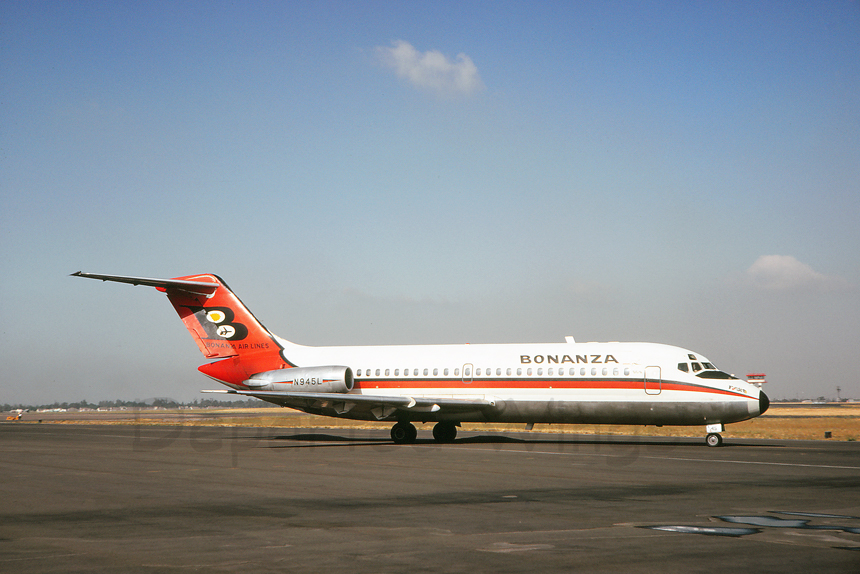
|
May 1968 As the first scheduled airline to start passenger services to Santa Ana-Orange County in 1952, Bonanza Air Lines also became the first airline to start true "jet" service into the airport when Douglas DC-9 flights were started in 1967. (The airline did advertise "jet" service with the introduction of its Fokker F-27 turboprops, however this was surpassed by the turbojet service provided by the new DC-9s) Dubbed the "FunJets," the DC-9s provided fast and efficient service to both Phoenix and Las Vegas. Seen taxiing outbound toward Runway 19 for a morning departure is N945L, a Douglas DC-9-11, and the first airframe delivered to the airline on December 19, 1965. |
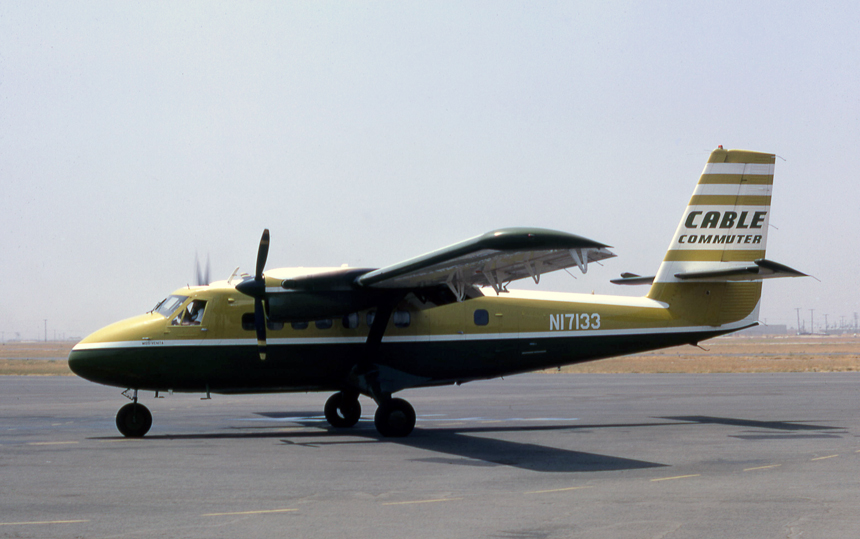
|
June 1968 One of the many local commuter airlines that was formed in Southern California during the 1960s, was Cable Commuter based at Ontario Airport. Cable focused on providing feeder flights throughout Southern California and into Los Angeles-LAX airport. Orange County was added to the schedule in May 1968, with no less then ten daily flights to Los Angeles. This convenient "shuttle" service became popular to passengers connecting to larger carriers and flights at Los Angeles International Airport. Cable Commuter only lasted a few years before they were consolidated by Aero Commuter Airlines from Long Beach to become Golden West Airlines a year later in 1969. On the ramp starting its engines for another short "hop" to the north is N17133 "Miss Venita," a de Havilland DHC-6-100, delivered new to the airline on February 26, 1968. |
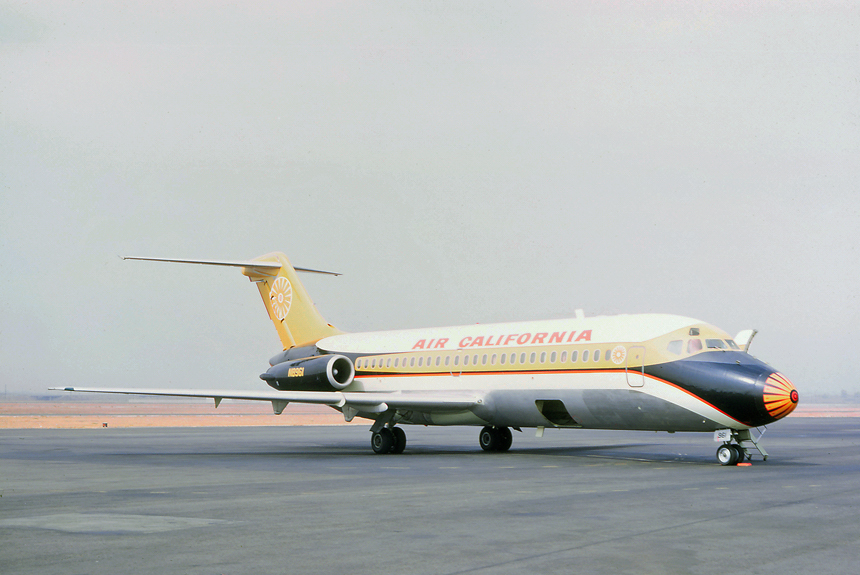
|
October 1968 The new entrant into the California intra-state market, Air California realized a few years after starting service with the Lockheed Electra that jet aircraft were a necessity to compete with the "Big Guys" on routes within the state. Initially the airline leased two Douglas DC-9s in 1968 for service on the popular Orange County-San Francisco route, while the Lockheed L-188 Electra's were placed on other city pairs. Parked on the ramp during a turn-around on an overcast afternoon is N8961, a Douglas DC-9-14, leased to Air California from Douglas Aircraft. |

|
March 1969 When Air California introduced "jet" Douglas DC-9 service, the airline continued to evaluate it aircraft options and decided on the Boeing 737 for its future jet aircraft needs. Air California leased two Boeing 737s from GATX-Boothe Aircraft Leasing after the planes came available after a cancelled order from Pacific Air Lines. The first 737 was delivered in early October 1968, and flights started a few days later on October 7, 1968, on the Orange County-San Francisco route. Seen taxiing outbound toward Runway 19 for an afternoon departure is N467GB, a Boeing 737-293, in the original "Sunburst" color scheme with the black "bandit" nose paint. |
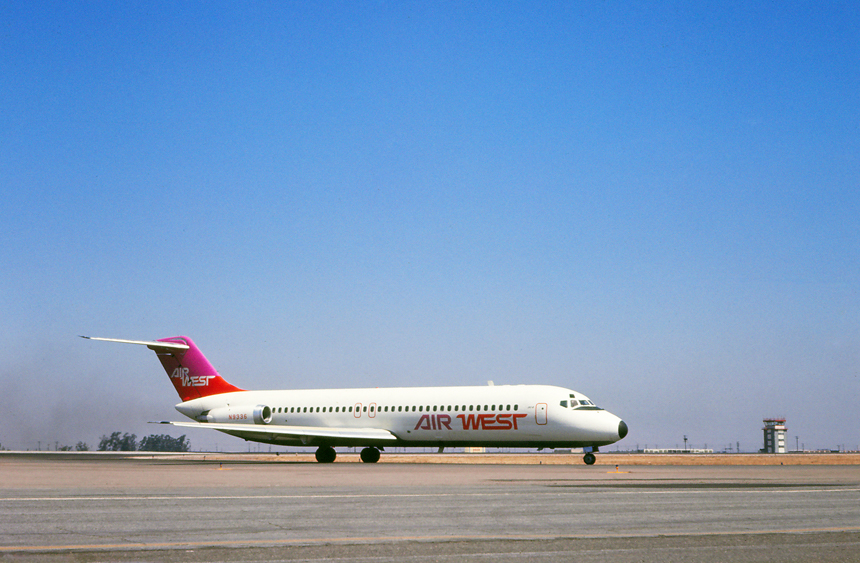
|
June 1969 Santa Ana-Orange County airport's first airline operator, Bonanza Air Lines was merged with two other local carriers, Pacific Air Lines and West Coast Airlines in April 1968, to form AirWest. The "new" airline continued to serve the airport with daily DC-9 "jet" flights to Phoenix and Las Vegas, and "Jet-Prop" F-27 service to both San Diego and Los Angeles. The airline proved quite popular with travelers as the only carrier to serve two out of state cities from the airport with no direct competition. Seen taxiing inbound toward the terminal after having landed is N9336, a Douglas DC-9-31, delivered new to the airline in November 1968. |
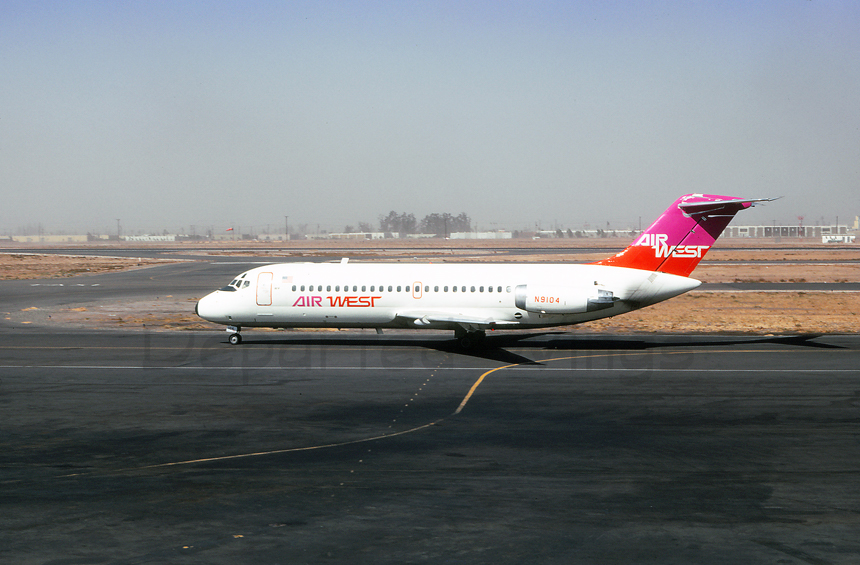
|
October 1969 By the fall of 1969, AirWest had five daily departures from Santa Ana-Orange County using the Douglas DC-9 on flights to Las Vegas, Phoenix, and San Diego. At the time, along with new entrant Air California, they were the only two airlines providing true jet service from the airport. Taxiing toward Runway 1 for an eastbound departure during a blustery Santa Ana wind event is N9104, a Douglas DC-9-10, originally delivered new to West Coast Airlines in August 1967. |
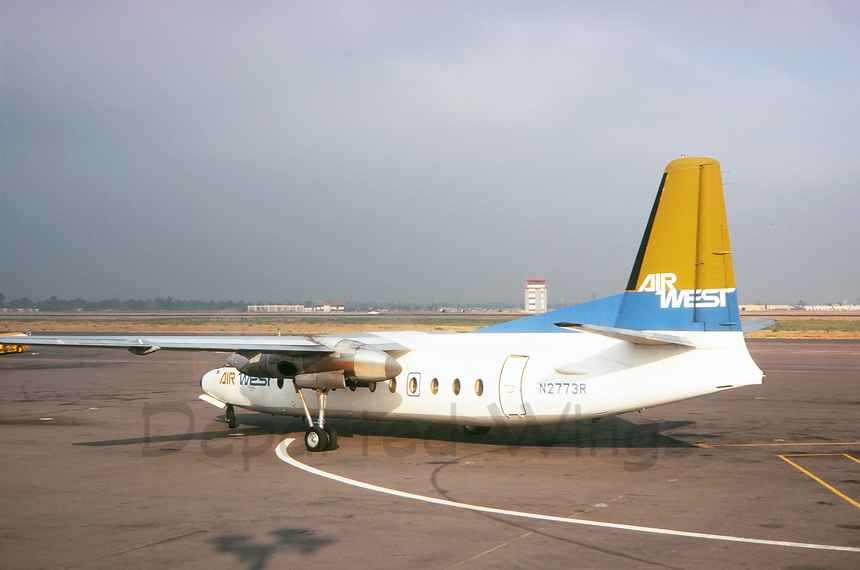
|
November 1969 Although having been replaced by additional turbojet equipment, the Fokker F-27 turboprops still found plenty of use with AirWest especially to smaller destinations throughout the route map. Santa Ana-Orange County saw the turboprops being used on services to both Los Angeles and El Centro-Imperial, before they stopped serving the airport in December 1969. Seen taxiing away from the terminal ramp for an afternoon departure and wearing the simple yet catchy two-tone livery is N2773R, a Fairchild F-27A, delivered to predecessor Pacific Air Lines in May 1959. |
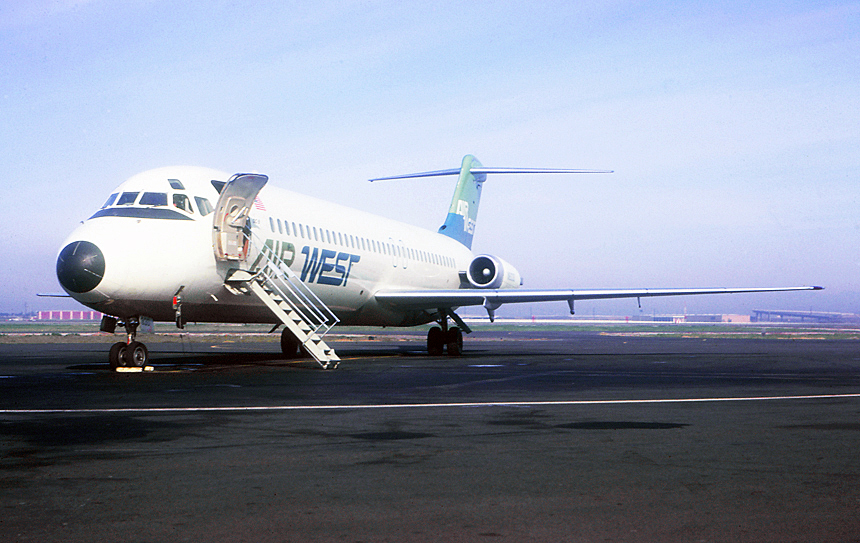
|
March 1970 AirWest continued to be the only airline to provide "jet" service from Orange County to destinations outside of California. The daily flights to both Phoenix and Las Vegas were popular with business and tourist class passengers alike. Parked on the ramp with the very convenient integral air stairs extended and awaiting its next load of passengers is N9330, a Douglas DC-9-31, originally destined for West Coast Airlines but taken up by Air West on May 27, 1968. |
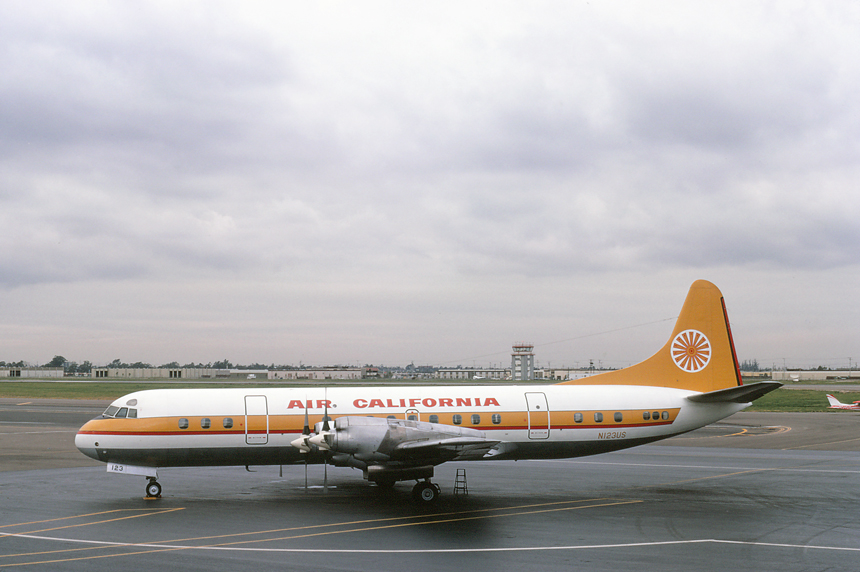
|
March 1973 Within a few years after starting service in 1967, Air California's Lockheed Electra's were placed on "secondary" routes as new jet aircraft were delivered and took the main intra-state routes. The Electra was still a formidable factor in the fleet during the early 1970s and was used on flights from Orange County to secondary cities as well as on charter services. Parked on a soggy ramp during a spring storm is N123US, a Lockheed L-188 Electra-C, originally delivered to Northwest Orient Airlines in August 1959 and purchased by Air California in July 1970. |

|
July 1976 The two biggest airlines serving Orange County-Santa Ana during the late 1970s were home-based Air California and Hughes Airwest. Both airlines usually terminated their daily flights at the airport, in preparation for early morning "business" flights the next day. Caught on a typical, balmy summer evening is a trio of Hugh Airwest Douglas DC-9s and a pair of Air California Boeing 737s, remaining-over-night. |

| June
1977 Southern California commuter Golden West Airlines continued to grow during the 1970s by adding new cities, routes, and increased frequencies. Service between Orange County-Santa Ana and Los Angeles continued to be the most popular route for the airline, however additional routes from the airport to Santa Barbara, Fullerton and Palomar-Carlsbad (north of San Diego) were started and helped bring passengers in from the regional area that wanted to bypass Los Angeles all together using Air California or continue on to major carriers at LAX. Taxiing outbound for take off and wearing the "earth-tone" colors of the 1970s is N64150, a de Havilland DHC-6-200 Twin Otter. |

| April 1978
Hughes Airwest had the distinction of being the first airline to serve Orange County-Santa Ana albeit though a series of mergers. Bonanza Air Lines first started flights into the airport as a stop on its Phoenix-San Diego-Los Angeles service using a Douglas DC-3 in 1951. Bonanza was eventually consolidated with Pacific Air Lines and West Coast Airlines to form Air West in 1968. Aviation mogul and billionaire Howard Hughes purchased Air West in 1970 branding the airline under his own name. Next to Air California, Hughes Airwest was the second largest carrier out of the airport and provided all of the flights "out" of California. By 1978, the airline had non-stop services from Orange County to Los Angeles, Las Vegas, and Phoenix. Parked at the terminal ramp and being prepared to turn around for another flight is N918RW, a Douglas DC-9-31, originally delivered to Eastern Airlines in January 1968, and purchased by Hughes Airwest in October 1977. |
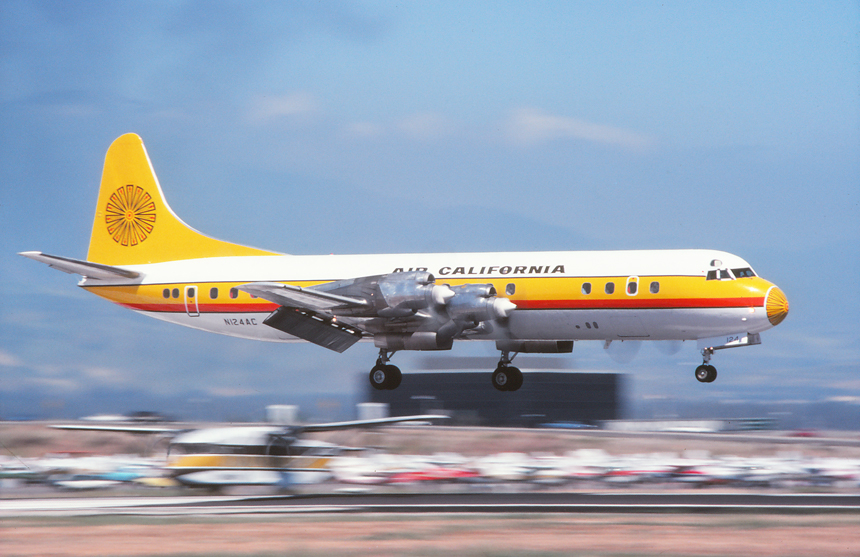
|
June 1978 Although the Electra's had been slowly phased out of the Air California fleet during the early 1970s, they got a new lease on life when the airline inaugurated service to South Lake Tahoe in 1975. The mountainous, high-elevation airport was best served by the four-engine "Prop-Jet" and the venerable Electra would maintain this important route into early 1980. Caught on "over-the-numbers" on Runway 19 Right for landing is N124AC, a Lockheed L-188 Electra-A, originally with Braniff International Airways in 1960, and purchased by Air California in 1975. |
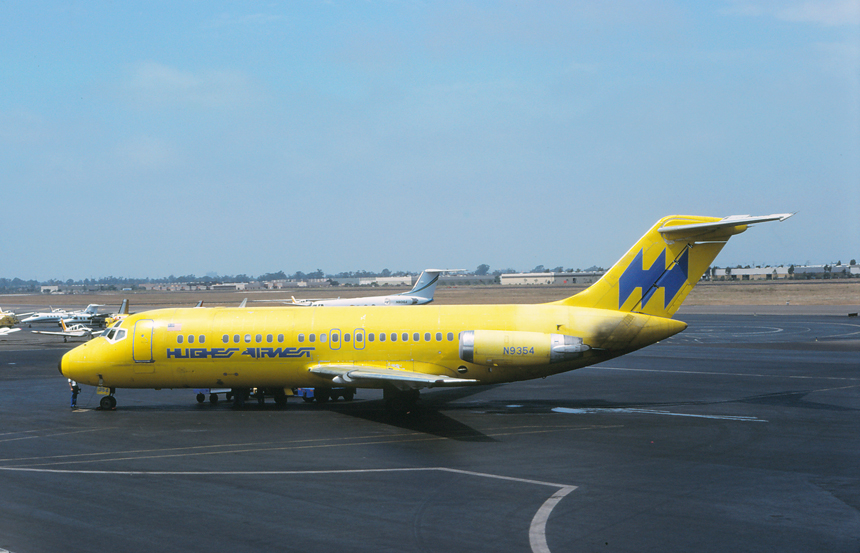
| August 1978 During the mid-1960s Continental Airlines proposed a concept of flying passengers during the day and cargo at night therefore provided ultimate utilization of new jet aircraft. The airline presented the idea to Douglas as the company's smaller DC-9 jet was perfect for those small markets where both services could be viable. The airline placed an order for twelve of the "Rapid Change" versions, which had a large side cargo door and an interior that could be quickly changed from passenger to cargo version with removable passenger "modules." The idea of a dual role airliner did not fare well for Continental and complaints from passengers were constant about the rattling and creaking of the modules. After only a few years of service, Continental put the aircraft up for sale. Hughes Airwest, seeking to expanded it's fleet, saw a bargain deal and purchased five of the DC-9s and had the passenger interiors converted to a permanent configuration. Parked on the tarmac, awaiting engine start and with the large cargo door still evident on the left side of the aircraft is N9354, a Douglas DC-9-15RC, originally delivered to Continental Airlines in October 1967, and purchased by Hughes Airwest in February 1975. |
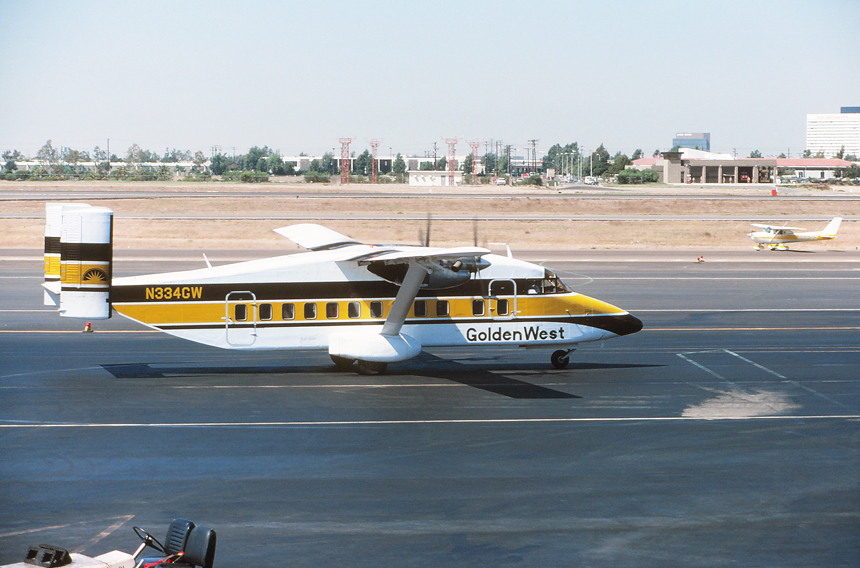
|
October 1979 Golden West Airlines, having been used the de Havilland DHC-6 Twin Otter as its aircraft of choice, ordered two Shorts SH-330 aircraft in 1977. The new, thirty passenger "wide-body" aircraft were to be used on trunk routes, and would also carry a flight attendant, the first for the airline. Golden West received its first SH-330 on July 5. 1977 and the plane was placed was placed on routes from Los Angeles to Santa Ana-Orange County and Ontario. Seen taxiing inbound toward the terminal complex is N334GW, a Shorts SH-330-100. |
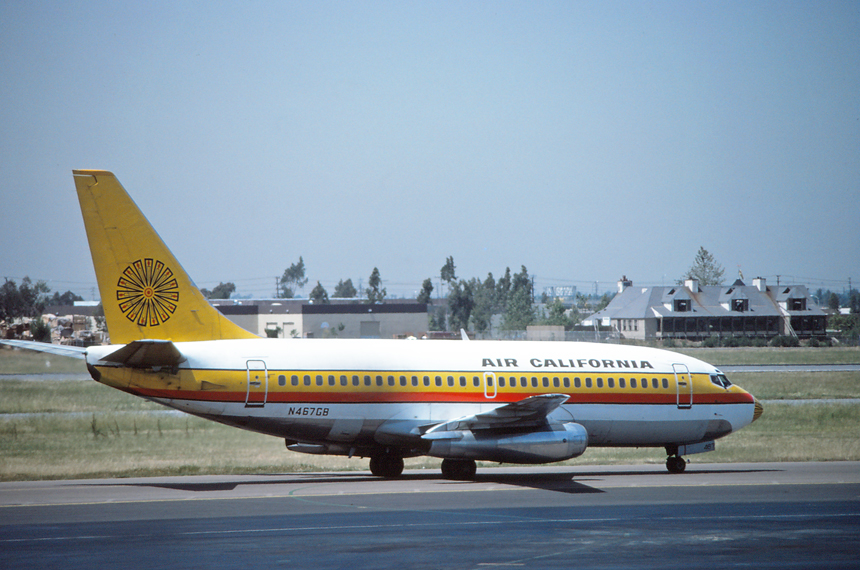
| April
1980 By 1980, Air California was the largest (out of three carriers) and most popular carrier operating from Orange County-Santa Ana airport. The hometown airline had become successful with its frequent flights and no-nonsense service. At the turn of the decade the airline had ten daily flights and was serving nine cities, seven in California and both Reno and Las Vegas in Nevada. Taxiing out to Runway 19 Right in a revised color scheme introduced in the early 1970s (see picture from 1969) is N467GB, a Boeing 737-293, delivered to Air California in October 1968. |
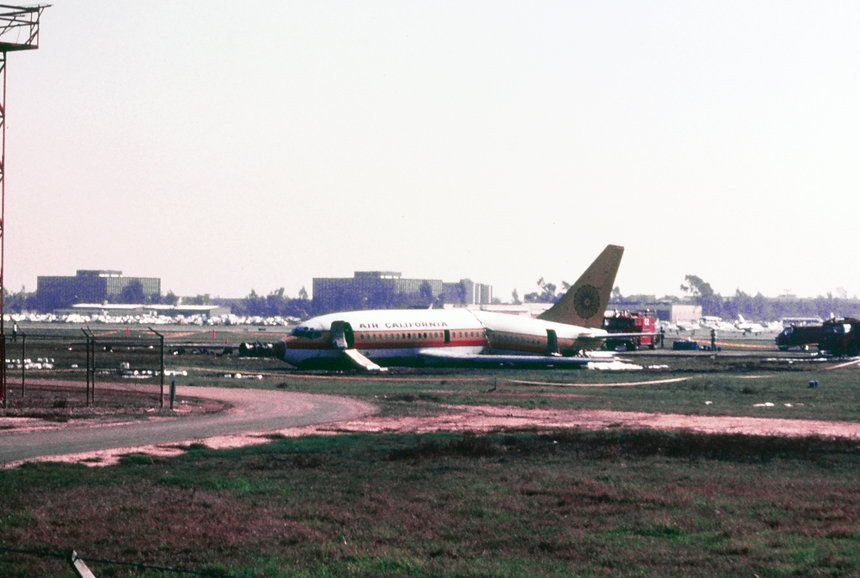
|
February 1981 Prior to 1981, Air California had a stellar record for safety. On February 17, 1981, while on approach to the airport after a non-stop service from San Jose, Air California Flight 336, was instructed to "go-around" on short final to Runway 19 Right due to traffic on the runway. The "go-around" was attempted to late as the aircraft touched down, resulting in the landing gear collapsing and the aircraft sliding down the end of the runway. Fortunately all passengers and crew survived the accident with only four serious injuries being reported. After investigation by NTSB, it was determined that the captain's failure to immediately initiate a "go-around" resulted in landing gear retraction and subsequent runway over-run. Pictured the following day with substantial damage is N468AC, a Boeing 737-293, delivered new to the airline in September 1970. |

| February 1981 With mergers abound, Republic Airlines was formed by the merger of North Central Airlines and Southern Airways in July 1979. The new airline focused primarily on services east of the Rockies, into the Midwest and Southeast. Seeking to truly become a National carrier, Republic placed a bid to purchase Hughes Airwest, which was approved and completed on October 1, 1980. With that purchase, Republic became a coast-to-coast carrier and actually took title of the largest airline in the Nation based upon number of cities served (almost 200). With Republic now serving Santa Ana-Orange County, passengers had better connections to an extensive route system. Along with the introduction of service by Republic, the airline added two new routes in early 1981 to both Salt Lake City and Tucson from Orange County. Parked on the terminal ramp during an afternoon turnaround and freshly painted in the "Herman" colors is N921RW, a Douglas DC-9-31, originally delivered to Eastern Airlines in January 1968, then purchased by Hughes Airwest in July 1977. Note the Hughes Airwest DC-9 in the background with hybrid "Republic" titles placed after the merger. |
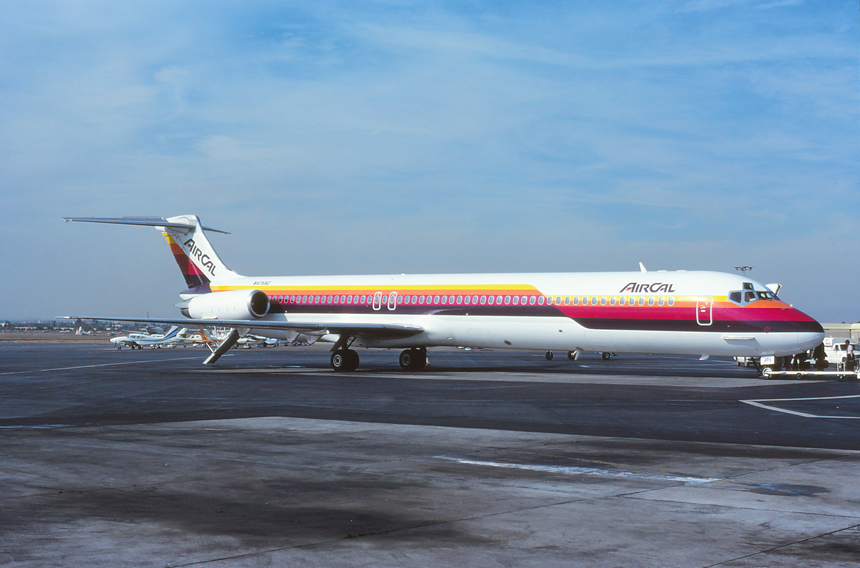
|
June 1981 Realizing the benefits the new McDonnell Douglas MD-80 airplane would have including the Stage II sound foot-print, critical to operations from noise sensitive Orange County, Air California placed an order for seven of the new planes. The first MD-80 entered service in May 1981, wearing the new corporate identity and colors of AirCal. Just a month old and parked on the ramp loading passengers for another Bay Area bound flight is N475AC, a McDonnell Douglas DC-9-81 (MD-81). |

|
July 1981 Los Angeles based Golden West Airlines had placed into service the Shorts SH-330 and had orders for the larger de Havilland "Dash 7" turboprop, however the smaller de Havilland DHC-6 Twin Otter continued to be the workhorse for the fleet. During 1981, flights from Orange County to Los Angeles, Ontario, and San Diego still used the rugged, Twin Otter. Taxiing through the general aviation ramp enroute to the terminal after a regional flight is N64150, a de Havilland DHC-6-200 Twin Otter. |

|
September 1981 One of the owners of AirCal, George Argyros was also the owner of the Seattle Mariners major league baseball team. As such, AirCal planes were used to charter the team during baseball season to games across the U.S. One such plane was christened "Mariner I" and was used specifically during the season, and placed back into the fleet rotation when not needed for the Mariners. Seen on short final to Runway 19 Right and wearing the bold, new AirCal color scheme is N465GB "Mariner I," a Boeing 737-293, delivered to Air California in October 1968. |
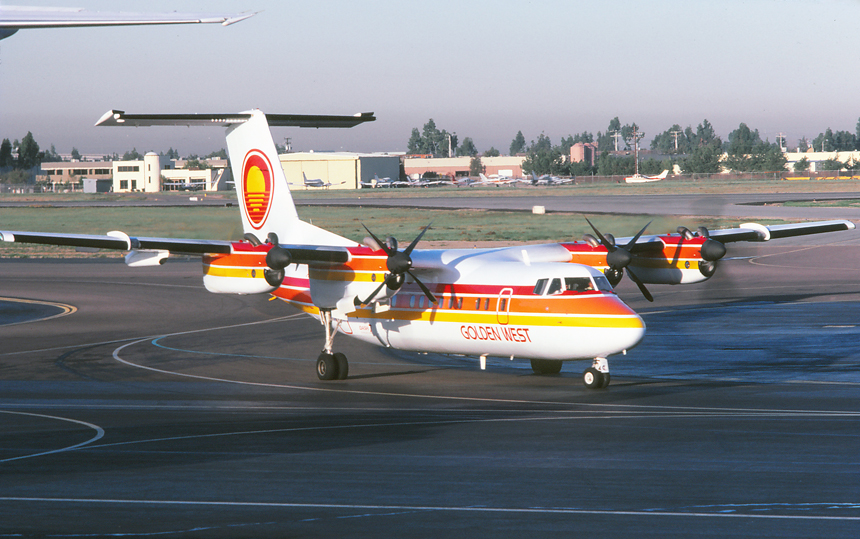
|
January 1982 By 1980, Golden West had grown to become one of the largest commuter carriers in the United States. Service to Santa Ana-Orange County Airport increased and by 1982, the airline was serving five cities from SNA including Ontario, Santa Barbara, and Lake Tahoe using their new de Havilland DHC-7, “Dash 7” four-engined turboprops. Golden West operated until April 1983 when the carrier entered bankruptcy and suspended operations. Wearing the striking colors of a California sunset, while taxiing into the terminal ramp area is N703GW, a de Havilland Canada DHC-7-102, delivered new to the airline in January 1981. |
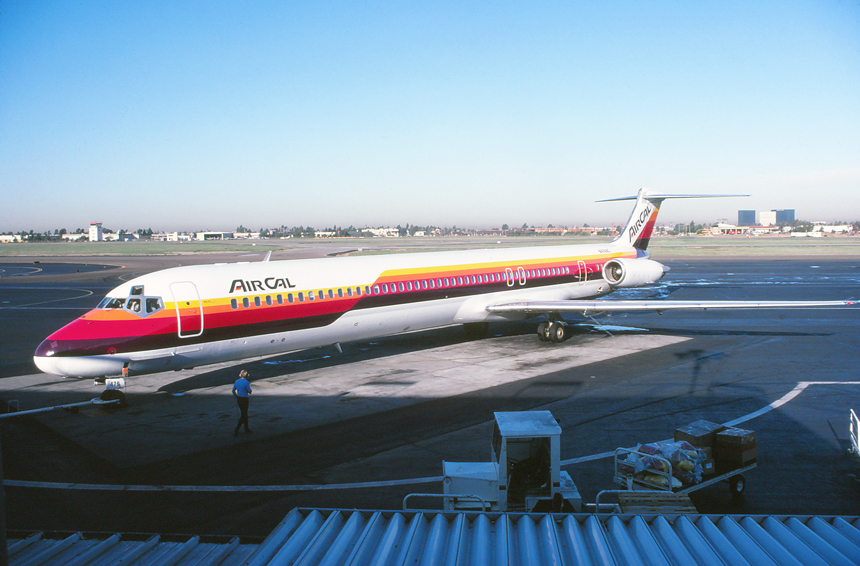
|
January 1982 AirCal was pleased with the performance, efficiency, and operating costs of their new McDonnell Douglas MD-80s. The neighbors surrounding the Santa Ana-Orange County Airport, especially in sensitive Newport Beach, seemed pleased with the "Stage III" noise characteristics of the new "Super 80s." Seen getting ready to be pushed back from the terminal for a morning departure is N479AC, a McDonnell Douglas DC-9-82 (MD-82) delivered new to the airline in November 1981. |
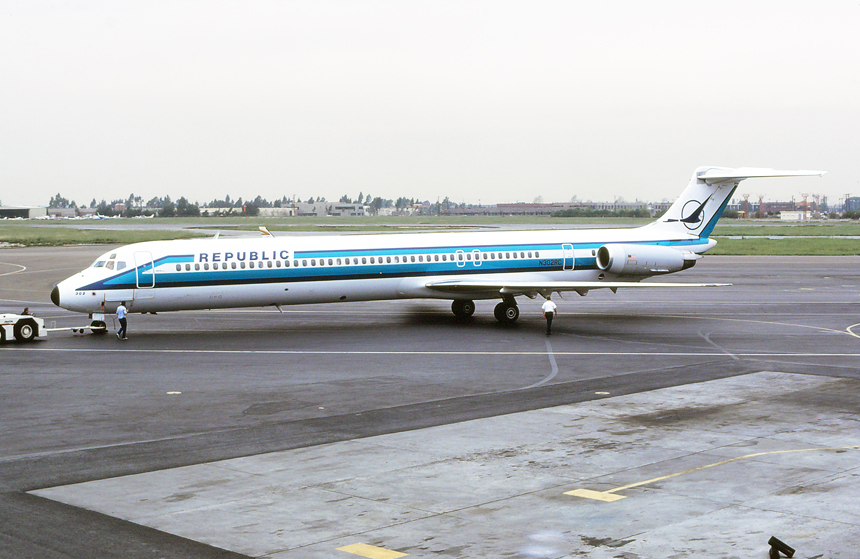
|
April 1982 Republic Airlines assumed the routes of Hughes Airwest when the airline was purchased by the carrier in September 1980. Republic Airlines was the first airline in the U.S. to have the McDonnell Douglas DC-9-82 (MD-82) delivered and placed in service after an order for eleven aircraft. The new planes were to be used to extend routes, increase capacity in specific markets especially Santa Ana-Orange County where the "Stage III" noise characteristics were a welcome change to the surrounding neighbors. From Orange County the MD-80 was placed on services to both Phoenix and Las Vegas starting in 1981. Seen being pushed back from the terminal for a mid-morning departure is N302RC, a McDonnell Douglas DC-9-82 (MD-82), delivered new to the airline in September 1981. |

|
June 2001* In January 2000, Aloha Airlines received Extended Twin Overwater Passenger Service (ETOPS) approval for their Boeing 737-700s and allowed the airline to start flights from Hawaii to the U.S. West Coast, specifically secondary markets that might have not had traffic for the larger aircraft or airlines. Realizing an opportunity to connect with the Orange County market, Aloha Airlines started the first ever scheduled non-stop service between John Wayne Airport and Honolulu, Hawaii on May 1, 2001. Non-stop flights to Kahului, Maui started a month later in June. Aloha service became quite popular as the only carrier serving the Hawaii market from the Orange County area. Seen preparing to taxi for a morning departure to the Island State is N742AL "Hawai'iloa," a Boeing 737-76N. |
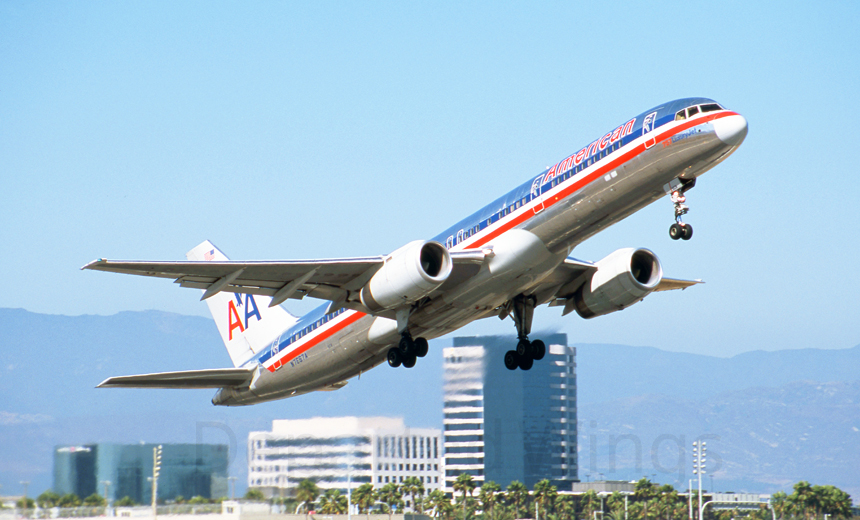
|
July 2003* Being introduced into passenger service in January 1983, the Boeing 757 established itself for decades as a versatile airframe with various passenger configurations and range options. One characteristic of the aircraft was its exceptional short-field performance, a quality Delta Air Lines initially took advantage of with flights into runway length-limited and noise-restricted John Wayne Airport in November 1987with services to Dallas-Ft. Worth and Salt Lake City. Within a year, other airlines followed suit, including American Airlines, America West Airlines, Northwest Airlines, and United Airlines. During the 1990s, eight airlines, including United Parcel Service-UPS, were operating the Boeing 757 into John Wayne, it becoming the largest passenger aircraft operating at the airport. Seen taking to a bright, summer sky on an early afternoon departure to Dallas Ft. Worth is N7667A, a Boeing 757-223. |
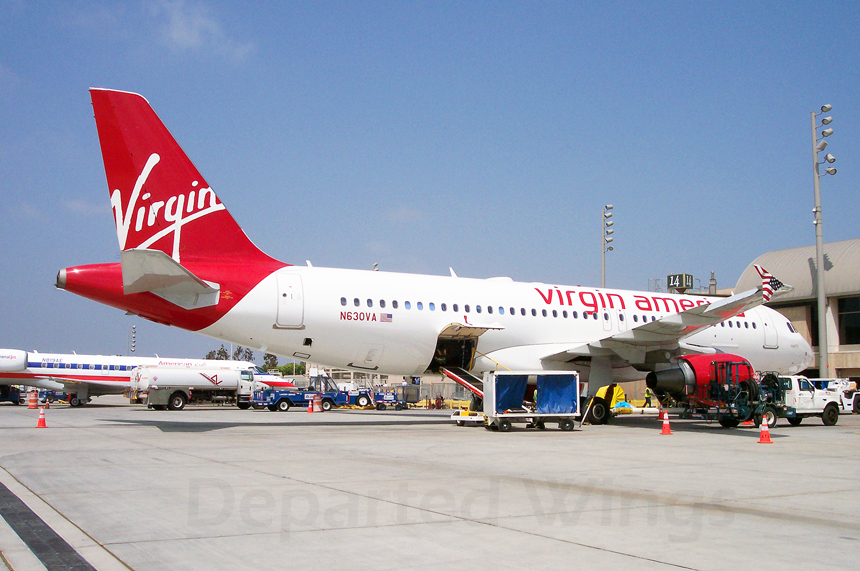
|
May 2009* Founded in 2004, by famous airline entrepreneur Richard Branson's Virgin Group, Virgin America was started as a low-cost high-quality service carrier initially operating along the West Coast of the U.S. with a hub at San Francisco. Approvals to start flights was delayed a few years because of ownership concerns, however flights commenced on August 8, 2007 between San Francisco, Los Angeles, and New York with Airbus A-320 aircraft. With innovative service and cheap fares the airline quickly expanded to destinations across the United States and Mexico. Service was started to John Wayne Airport on April 30, 2009 with five daily flights to San Francisco. Although the airline was popular in providing a number of convenient flights to the Bay Area, the airline suspended service just over a year later on May 26, 2010. Seen parked at the terminal and being serviced for its next departure is N690VA "Superfly," an Airbus A-320-214. |

|
April 2010* As the first international carrier to start service into John Wayne Airport, Air Canada saw opportunity for business and leisure travelers flying to Orange County as well as providing convenient connections via Toronto to European destinations. Because John Wayne did not yet have a customs facility, agreements were made for Orange County bound travelers to clear U.S. Customs at Toronto before departure. Service started on April 8, 2010 with a single daily flight each way to Toronto using an Airbus A-319. Although there were high hopes for the new service, the airline quickly realized the route was not economically viable and suspended service only six months later on October 30, 2010. Seen awaiting taxi clearance for a morning departure on its inaugural service to Toronto and wearing the "Horizons Enfance" program stickers, is C-GBIP, and Airbus A-319-114. |

|
May 2011* On the heels of Air Canada's departure from John Wayne Airport in October 2010, low-cost Canadian carrier WestJet inaugurated service to the Orange County area with a daily non-stop flight to Vancouver, Canada on May 5, 2011. Becoming the second international carrier to start service to Orange County, a month later in June the carrier started non-stop John Wayne Airport-Calgary service just in time for the summer season. Seen taxiing out toward Runway 19 Right for a mid-morning departure and seen just days after starting service, is C-GWJF, a Boeing 737-7CT. |

|
October 2012* Interjet Airlines was a Mexico City based low-cost carrier that started operation on December 1, 2005 using an Airbus A-320. The airline quickly gained popularity assuming routes of defunct Mexicana Airlines and Aerocalifornia. As the airline expanded across North America, it saw an emerging market in the Orange County region and inaugurated daily, non-stop service from John Wayne Airport to both Guadalajara and Mexico City, Mexico on October 11, 2012. Interjet would become the third international airline to provide service to John Wayne Airport after Air Canada and WestJet Airlines in previous years. Although the airline provided a direct service to two of the largest cities in Mexico, load factors were never high and the airline suspended all operations from John Wayne Airport on July 19, 2014. Here flight 2941 is seen taxiing toward Runway 19 Right for a mid-morning departure to Mexico City using XA-XII, an Airbus A320-214. |
Back to: The Airports